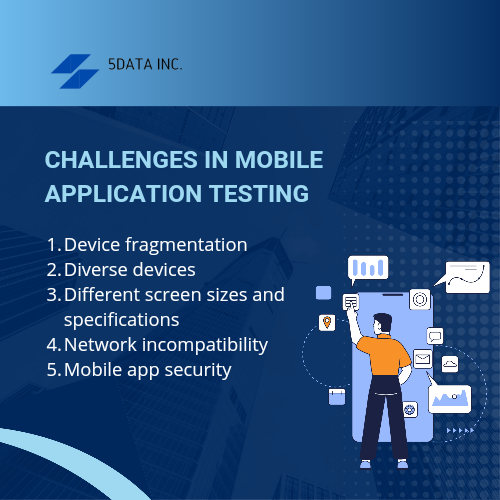What we cover in this blog
Mobile App Testing Challenges And Ways To Overcome Them
Mobile app testing requires QA teams to have a deep knowledge of the various testing strategies using testing tools on OS versions of different devices. Some of the tools include performance monitoring tools, automation tools, analytical tools (like AppBlade, TestFlight, HockeyApp, and FireBase), network tools, and emulator and simulator tools like Xcode, Genymotion, and others.
Along with the factors the top mobile-performing testing services consider while testing mobile apps, a few challenges the testing team may face in the process are mentioned below.
Challenge #1: Device fragmentation
Device fragmentation means the use of different versions of OS on the same brand of mobile devices by multiple users. It happens due to the installation of software updates by some users while other users use the older version contemporarily. Upgradation to a newer version of the same OS can pose trouble for native apps meant to be used specifically for the Android, Apple, or other operating systems.
Also, various versions make it difficult for software developers to release several versions of the same mobile app, especially hybrid apps, to be compatible with individual mobile devices.
Solution:
The solution lies in making app upload easy in a single click to be used by various devices. Application testing should be done using various cloud-based app testing tools, including AWS Device Farm, Xamarin Test Cloud, and Perfecto.
Focus factor: Testing of functionality and usability
The mobile app testing strategy of the top mobile application testing services would not miss out on carrying out functional tests on mobile emulators. Emulators denote the hardware or software that lets the host computer system act as a guest computer system to run software designed for the latter. The computer system imitates another system to let software developers understand how the mobile app would function in the guest environment. It allows rectifying any defects or malfunctions likely to pop up on real devices.
Testing should also be done on real mobile devices to estimate the usability of the mobile apps.
Challenge #2: Diversity of devices
The diversity of products in the electronics market provides various choices for smartphone users, giving rise to the need to test mobile apps across several operating systems.
Solution:
Testers must check for compatibility across a diverse range of tablets and smartphones using tools like Testingbot, Lambdatest, BrowserStack, and Function. Along with automated testing, manual testing using emulators and simulators should be done where applicable to spot unusual bugs that may affect the app’s usability in the actual device.
Focus factor: Testing on several configurations
For wide exposure to their target audience, it becomes important for the mobile app tester to focus on several configurations available on multiple devices for testing apps. Progressive web apps that depend on the browser should also be checked to function well and provide a consistent user experience on all devices.
Challenge #3: Different screen sizes and specifications
Different mobile phones come with different screen specifications. While some mobile phones come with foldable screens, others may have a regular screen with a different resolution. When an app fails to adapt properly across some dimensions, key features may be absent from the screen. In such cases, the user would uninstall it and switch on to another app.
Solution:
A mobile app’s responsiveness can be tested using several cross-browser testing tools, including QA Wolf, LambdaTest, CrossBrowserTesting, Katalon Studio, and TestComplete.
Focus factor: Testing across various screen resolutions
When testing an app, screen size, and specifications are important factors to consider since they might reveal issues that adversely affect the app’s layout. Testing should be done for the Portrait and Landscape modes so that mobile users can view the app completely on their screen.

Challenge #4: Network incompatibility
Some mobile apps come with augmented reality features embedded in them. For instance, you may want to purchase some jewelry online, and the mobile app allows you to virtually try on the jewelry piece and see how it looks on you before you purchase. If the feature works only on a Wi-Fi network at 5G speed, 4G smartphone users would find the app non-functional.Solution:
Testing mobile applications in offline mode can help to rectify the issue. Also, simulating and monitoring the network conditions on Android operating system and iOS devices can help.Focus factor: Testing across different network speed
Mobile testing should be done so that data communication is not lost in the app and it can work on cellular and Wi-Fi networks of varying speeds.Challenge #5: Security of the mobile app
The multiple permutations of mobile apps can make them less secure than web apps.Solution:
Thorough security testing during app development can help to overcome security breaches.Focus factor: Automated and manual testing
Mobile app testing tools like Testsigma, Espresso, Roboitium, UI Automator, and others help to conduct automated tests to ease the repetitive, time-consuming tests. These tools are useful for automated testing of native and hybrid mobile apps too.Challenge #6: Global usage of the app
The mobile app may not be accessible to various demographics across several geographic locations, failing which the app could result in a poor user experience at the location.Solution:
Localization testing done by the top mobile application testing services helps to check and improve the accessibility of the app at a specific location with tools like XCUItests, Appium, and Espresso.Focus factor: Updating local settings to test different scenarios
We need to change the language preferences and local settings while testing on several iOS and Android devices.Conclusion
Although we cannot create applications for every device, we must ensure that the mobile application is consistent for all end users. Additionally, mobile app testing should ensure that the app’s features and varied components are inclusive, consistent, and of the highest quality.
Priyamvada
Author
